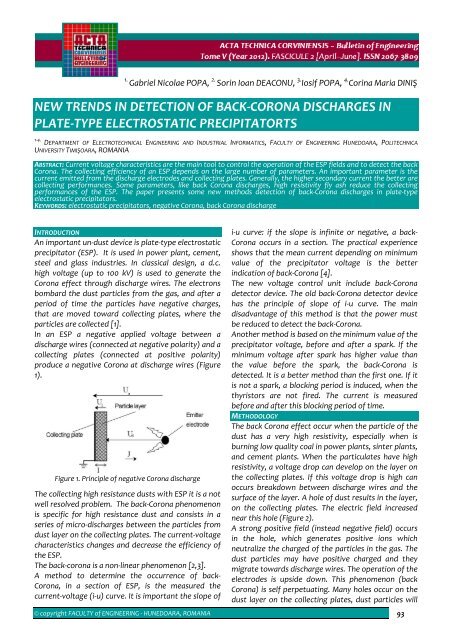Editorial & Advisory Board - Acta Technica Corviniensis
Editorial & Advisory Board - Acta Technica Corviniensis
Editorial & Advisory Board - Acta Technica Corviniensis
Create successful ePaper yourself
Turn your PDF publications into a flip-book with our unique Google optimized e-Paper software.
1.<br />
Gabriel Nicolae POPA, 2. Sorin Ioan DEACONU, 3. Iosif POPA, 4. Corina Maria DINIŞ<br />
NEW TRENDS IN DETECTION OF BACK‐CORONA DISCHARGES IN<br />
PLATE‐TYPE ELECTROSTATIC PRECIPITATORTS<br />
1‐4.<br />
DEPARTMENT OF ELECTROTECHNICAL ENGINEERING AND INDUSTRIAL INFORMATICS, FACULTY OF ENGINEERING HUNEDOARA, POLITECHNICA<br />
UNIVERSITY TIMIŞOARA, ROMANIA<br />
ABSTRACT: Current voltage characteristics are the main tool to control the operation of the ESP fields and to detect the back<br />
Corona. The collecting efficiency of an ESP depends on the large number of parameters. An important parameter is the<br />
current emitted from the discharge electrodes and collecting plates. Generally, the higher secondary current the better are<br />
collecting performances. Some parameters, like back Corona discharges, high resistivity fly ash reduce the collecting<br />
performances of the ESP. The paper presents some new methods detection of back‐Corona discharges in plate‐type<br />
electrostatic precipitators.<br />
KEYWORDS: electrostatic precipitators, negative Corona, back Corona discharge<br />
INTRODUCTION<br />
An important un‐dust device is plate‐type electrostatic<br />
precipitator (ESP). It is used in power plant, cement,<br />
steel and glass industries. In classical design, a d.c.<br />
high voltage (up to 100 kV) is used to generate the<br />
Corona effect through discharge wires. The electrons<br />
bombard the dust particles from the gas, and after a<br />
period of time the particles have negative charges,<br />
that are moved toward collecting plates, where the<br />
particles are collected [1].<br />
In an ESP a negative applied voltage between a<br />
discharge wires (connected at negative polarity) and a<br />
collecting plates (connected at positive polarity)<br />
produce a negative Corona at discharge wires (Figure<br />
1).<br />
Figure 1. Principle of negative Corona discharge<br />
The collecting high resistance dusts with ESP it is a not<br />
well resolved problem. The back‐Corona phenomenon<br />
is specific for high resistance dust and consists in a<br />
series of micro‐discharges between the particles from<br />
dust layer on the collecting plates. The current‐voltage<br />
characteristics changes and decrease the efficiency of<br />
the ESP.<br />
The back‐corona is a non‐linear phenomenon [2,3].<br />
A method to determine the occurrence of back‐<br />
Corona, in a section of ESP, is the measured the<br />
current‐voltage (i‐u) curve. It is important the slope of<br />
i‐u curve: if the slope is infinite or negative, a back‐<br />
Corona occurs in a section. The practical experience<br />
shows that the mean current depending on minimum<br />
value of the precipitator voltage is the better<br />
indication of back‐Corona [4].<br />
The new voltage control unit include back‐Corona<br />
detector device. The old back‐Corona detector device<br />
has the principle of slope of i‐u curve. The main<br />
disadvantage of this method is that the power must<br />
be reduced to detect the back‐Corona.<br />
Another method is based on the minimum value of the<br />
precipitator voltage, before and after a spark. If the<br />
minimum voltage after spark has higher value than<br />
the value before the spark, the back‐Corona is<br />
detected. It is a better method than the first one. If it<br />
is not a spark, a blocking period is induced, when the<br />
thyristors are not fired. The current is measured<br />
before and after this blocking period of time.<br />
METHODOLOGY<br />
The back Corona effect occur when the particle of the<br />
dust has a very high resistivity, especially when is<br />
burning low quality coal in power plants, sinter plants,<br />
and cement plants. When the particulates have high<br />
resistivity, a voltage drop can develop on the layer on<br />
the collecting plates. If this voltage drop is high can<br />
occurs breakdown between discharge wires and the<br />
surface of the layer. A hole of dust results in the layer,<br />
on the collecting plates. The electric field increased<br />
near this hole (Figure 2).<br />
A strong positive field (instead negative field) occurs<br />
in the hole, which generates positive ions which<br />
neutralize the charged of the particles in the gas. The<br />
dust particles may have positive charged and they<br />
migrate towards discharge wires. The operation of the<br />
electrodes is upside down. This phenomenon (back<br />
Corona) is self perpetuating. Many holes occur on the<br />
dust layer on the collecting plates, dust particles will<br />
© copyright FACULTY of ENGINEERING ‐ HUNEDOARA, ROMANIA 93

















